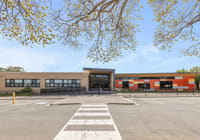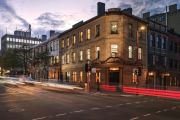
Sydney city sandstone precinct to be transformed to tourism hub
Sydney’s heritage sandstone buildings precinct in the heart of the city is undergoing the final stage of redevelopment which will create a new tourism destination adjacent to the newly opened upmarket Capella Sydney hotel.
Capella Sydney is a two-phase restoration project, comprising two heritage-listed buildings – the former Department of Education building and Department of Lands building – collectively known as the Sandstone Precinct. They sit in Bridge Street on the corner of Loftus Street.
Stage one included the completion of the $300 million Capella Sydney, with 192 rooms and a $6430-per-night top suite, undertaken by Australian construction firm Built on behalf of the Singapore-based Pontiac Land Group. The second stage, that will complete the project, is the redevelopment of the adjacent Lands building across Loftus Street.

“Significant trust has been extended to Pontiac Land to meticulously reimagine these historically important buildings and open them to the public for the first time,” Pontiac Land Group chief executive David Tsang said.
“The preservation of these buildings therefore requires a construction partner with in-depth knowledge of the historical significance and cultural value of the precinct.”
The NSW government sandstone buildings were leased by Property and Development NSW to Pontiac Land Group in 2015 to allow for their adaptive reuse as a luxury boutique hotel, with lease proceeds reinvested into frontline government services and other infrastructure.
The developer beat a large field of contenders for the long-term lease of the former Lands Building at 23-33 Bridge Street and the 1915 Education Building at 35-39 Bridge Street, between Martin Place and Circular Quay.
Being heritage-listed, Government Property NSW retains custodianship of the buildings, and will oversee the transformation during the development approval and construction phases.
Built chief executive Brett Mason, said the redevelopment of the Sandstone Precinct is a “once-in-a-lifetime project that will restore public access and give new life to two of Sydney’s most important heritage buildings”.
“Having worked closely with Pontiac Land Group over the last seven years, we’re very proud and grateful to be entrusted to bring the next stage of their vision to life,” Mason said.
Works will include the sensitive strip-out and refurbishment of heritage features, as well as structural upgrade of the building. The project is seven levels covering 10,500 square metres of space and construction will involve a hybrid use of existing, heritage, and new construction materials.
Mason said the extended Capella Sydney is expected to become one of the largest privately funded tourism infrastructure projects in NSW and one of the largest job-creating foreign investments in Sydney. The Department of Lands building is targeted to be completed in 2026.
Nearby, private group Mulpha has been upgrading its Intercontinental Hotel on the corner of Bridge, Philip and Macquarie Streets, which includes the heritage Transport House.
Unique office space in Transport House is being marketed for lease by Al Dunlop and Celia Gore of Knight Frank with Joshua Bush of Mulpha Australia. Existing tenants in the building include premium spirits’ company Diageo and international communications network M&C Saatchi.
Transport House was designed by H.E. Budden & Mackey in 1938 to house the Department of Road Transport and Tramways. Conversation works were undertaken in 2009 to preserve and improve the building.
Bush said the new developments in the surrounding area near Transport House, including the Quay Quarter Tower at 50 Bridge Street, was attracting tenants back to the northern end of the city.

“We have refurbished the Phillip Street entrance to the building, with a new wine bar called Bar Messenger now accessible through this entrance, as well as completing a new end-of-trip facility,” Bush said.
“Meanwhile there is plenty of amenity surrounding the building now, including the Aster Bar on the rooftop of the neighbouring InterContinental and the Pont Brasserie within the hotel.”
Gore added that the CBD precinct surrounding Transport House is undergoing a revitalisation following five to seven years of construction work.
“The north end of Phillip Street, where Transport House has a refurbished second entrance, is now a very attractive place to work having been transformed by the many improvements leading to new amenity including bars, restaurants, gyms and connectivity through laneways,” Gore said.











